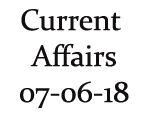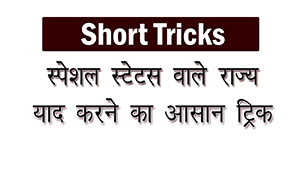-
Current Affairs 7th June 2018
Updated : 07-Jun-2018
Current Affairs 7th June 2018 - Important Points
- President approved promulgation of Insolvency and Bankruptcy Code (Amendment) Ordinance, 2018 on - 6th June 2018
- Rs. 8500 Crore Bailout Package for Sugar Industry Approved by - The Union Cabinet
- IBSA Ministerial Meet held at - Pretoria, South Africa
- RBI Hikes Repo Rate to - 6.25%
- Funding for Atal Bhujal Yojana approved by - World Bank
- India’s Current Maternal Mortality Ratio is 130 by - World Health Organisation
Current Affairs 7th June 2018 - Details
President approved promulgation of Insolvency and Bankruptcy Code (Amendment) Ordinance, 2018 on - 6th June 2018
President Ram Nath Kovind approved the promulgate the Insolvency and Bankruptcy Code (Amendment) Ordinance, 2018 on June 6 th , 2018. The Regulation provides noteworthy relief to home-buyers by recognising them as financial creditors.
Home-buyers: Biggest beneficiaries of the ordinance- From now onwards, home-buyers will have depiction in the Committee of Creditors and will be an essential part of the decision-forming procedure.
- Home-buyers will have the authority to initiate a resolution procedure against the bankrupt real estate firms and get their money returned.
- It will also permit home-buyers to appeal Section 7 of the Insolvency and Bankruptcy Code (IBC), 2016 against sinful developers.
Insolvency and Bankruptcy Code (Amendment) Ordinance 2018 - The committee of creditors’ voting rights of resolution plans will be restricted to 66% from previous threshold of 75%, and this initiative will help gear-up the resolution procedure.
- The Ordinance also delivers for a process to permit participation of security holders, depositors and all other classes of financial creditors in the meetings of the Committee of Creditors.
Section 29(A) of the IBC, 2016 has been revised to excused pure-play financial components from being ineligible on account of NPA. - Taking into consideration the wide variety of disentitlements contained in Section 29(A) of the Code, the Ordinance delivers that the Resolution Applicant shall deposit an certifying affidavit for its entitlement to bid.
- Promoters of organisations with business about Rupees 250 crores will be permitted for bid.
The ordinance suggests to facilitate implementation of the resolution strategy by the successful bidder. - It delivers a year time to the Resolution Applicant to get essential statutory clearances from central, state and other the ruling classes.
- The other amendments brought about by the Ordinance are non-applicability of suspension period to implementation of guarantee; and liberalising terms and conditions of provisional finance to enable financing of corporate debtor.
Rs. 8500 Crore Bailout Package for Sugar Industry Approved by - The Union Cabinet
The Union Cabinet led by PM has sanctioned a Rupees 8500 Crores bailout package for the troubled
sugar industry in the nation.
Government EffortsThough government deregulated sugar industry partially in 2013 and permitted them to trade their
produce in open market, the sugar industry faces a curious problem of fixed raw material price by state
and central governments as State Advised Price and Fair and Remunerative Price correspondingly. The
government-maintained cane prices are good-looking to farmers, but harm due to any decrease in the
prices of sugar in open market has to be tolerated by the sugar industry. Additionally, nonappearance of
ethanol production infrastructure ensures that the excess making of sugarcane is not optimally
captivated.
Current Package
This package proclaimed on June 6 th , 2018 comprises Rupees 4500 crores soft credit for ethanol
production capacity and Rupees 1540 crores production connected direct payments to cane-farmers by
sugar manufacturers. Further, government has also scrambled import-duty on sugar to control the plenty problem. Government has also finalised to create some sugar stock.
Did you know?- India is world’s 2nd largest sugar producer after Brazil with production of approximately 25 million
tonnes of sugar per year. Presently, Uttar Pradesh is India’s leading sugar producing state which is likely to uphold this position for the coming 2 years. Maharashtra is on 2 nd position in production of both sugarcane and sugar. - The plentiful sugarcane harvest has developed issue of plenty for already problemed cane farmers, sugar mills and state/centre governments. Higher purchase price of sugarcane and low sale price of sugar in open market results into stress on sugar mills and they are not able to complete payments to farmers, thus results into buildup of arrears.
IBSA Ministerial Meet held at - Pretoria, South Africa
A meeting of external affairs ministers of India with Brazil and South Africa was held in Pretoria, South
Africa. This ministerial summit led by India’s External Affairs Minister Sushma Swaraj was appeared by
South African Minister of International Affairs and Cooperation Lindiwe Sisulu and the Brazilian Foreign Affairs Deputy Minister Marcos Bezerra Abbott Galvao.
The result of this meeting was a document called as “IBSA Declaration on South-South Cooperation”.
This document demands for contribution of every India-Brazil-South Africa forum member to support to greater understanding of progress collaboration as a common endeavour of the global South.
More about IBSA- India-Brazil-South Africa Dialogue Forum is a tri-partite group which provisions promotion of
collaboration in numerous fields between these 3 important poles of South-South cooperation. Main aim of India-Brazil-South Africa include:
1. To encourage South-South cooperation by making a significant axis between 3 important nations
of 3 continents i.e. India, Africa and South America.
2. To shape consensus on matters of international importance including UN and UNSC reforms and
reforms in Bretton-woods Organizations.
3. To upsurge trade and exchange of data between the 3 nations and their efforts in
international poverty mitigation and social progress. - India-Brazil-South Africa forum was formed in 2003 via Brasilia Declaration by external affairs ministers of India, Brazil and South Africa.
RBI Hikes Repo Rate to - 6.25%
The 6 members Monetary Policy Committee of Reserve Bank of India has finalised to hike Repo to 6.25
per cent from 6 per cent, on June 6 th , 2018. According to the 2 nd Bi-monthly Monetary Policy Statement, the present policy rates of Reserve Bank of India would be as follows:
1. Repo Rate: 6.25%
2. Reverse Repo Rate: 6%
3. Marginal Standing Facility Rate: 6.50%
The fresh increase of 25 base points in important policy rates is for the 1st time in 4.5 years since NDA
government was shaped in May, 2014.
Repo Rate
Repo rate/repurchase rate, is the rate at which Reserve Bank of India loans to banks for small periods.
This is accomplished by Reserve Bank of India buying government bonds from banks with a contract to
sell them back at an immovable rate. When Reserve Bank of India upsurges Repo Rate, the banks can
borrow less at a lesser cost and thus essential to loan at higher rates. This contributes to increase of the
interest rates in markets. When Reserve Bank of India upsurges the repo rate, this is generally known as
a tight monetary policy stance.
Reverse Repo Rate
Reverse repo rate is the rate of interest at which the Reserve Bank of India borrows funds from other
banks in the short term. This is done by Reserve Bank of India selling government bonds or securities to
banks with the promise to buy them back at an upcoming date. The banks practice the reverse repo
ability to deposit their short-termed excess funds with the Reserve Bank of India and receive interest on
it. Reserve Bank of India can decrease liquidity in the banking system by growing the rate at which it
borrows from banks.
When the Reserve Bank of India increases the Reverse Repo, it means that now the Reserve Bank of
India will provide additional interest on the money which it borrows from the banks. An upsurge in
reverse repo rate means that banks receive higher returns by lending to Reserve Bank of India. This
specifies a hike in the deposit rates.Funding for Atal Bhujal Yojana approved by - World Bank
The World Bank has sanctioned Water Resources and River Development Ministry’s Rupees 6000 crores central ‘Atal Bhujal Yojana’. The scheme will be executed over a period of 5 years from 2018-19 to 2022-23 with support from the World Bank. The scheme suggestion has already been suggested by the Expenditure Finance Committee and the Ministry will be looking forward Cabinet endorsement for the project shortly.
Key Objectives- Making sure active community participation in groundwater management.
- Making sure active participation of the activities such as formation of Water User Associations, monitoring and disseminating ground water data, water budgeting, gram-panchayat wise water security plans and IEC activities related to sustainable ground water management.
- Permitting better thoughtful of the ground water regime.
- Permitting focused and integrated community wise approach for addressing matters related to ground water reduction.
- Empowering sustainable ground water management via convergence of on-going and fresh schemes.
- Funding Under the scheme, funds will be issued to the states for solidification the institutions responsible for the governance of ground water and for inspiring community participation for enlightening ground water management to foster behavioural changes for promoting conservation and efficient usage of water.
- The funds will be issued to the participating states in form of grants.
India’s Current Maternal Mortality Ratio is 130 by - World Health Organisation
The registrar general of India has published new information showing noteworthy decline in maternal
mortality ratio of the nation.
Maternal Mortality and MMR
As per to World Health Organisation, Maternal Mortality is death of a woman while pregnant or within
42 days of termination of pregnancy. Maternal Mortality Rate is death of such women/100,000 live
births. Maternal and child mortality and injuries are taken as significant health indicators because they
reflect the state of female healthcare.
Global Maternal Mortality Rate
The worldwide Maternal Mortality Ratio for year 1990 was 385. In 2015, this number stood at 216,
showing a decline of 44 percent in 25 years. Most of the universal maternal deaths occur in Sub-Saharan Africa i.e. 66 percent, followed by South Asia 22 percent.
Maternal Mortality Rate in India and its states- In the 2011-13 period, India’s Maternal Mortality Ratio was 167. According to the freshly released
information, the Maternal Mortality Ratio during 2014-16 period is 130. - Significant drop of 246 to 188, was noticed in the Empowered Action Group states and Assam.
Empowered Action Group states are those states where economic and progress pointers are a specific concern. - Such states are Bihar, Chhattisgarh, Jharkhand, MP, Odisha, Rajasthan, Uttarakhand and UP.
- MMR is one of the significant measures of the quality of safe deliveries and maternal care and India has padded behind China, Maldives and Sri Lanka in its neighbourhood.














